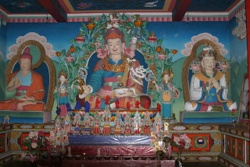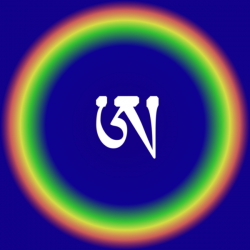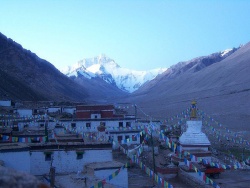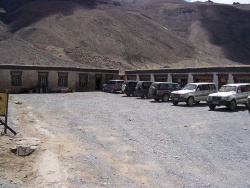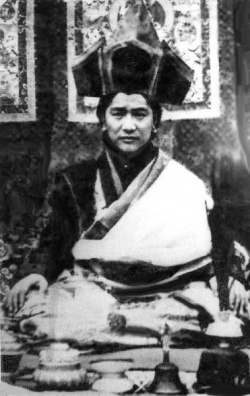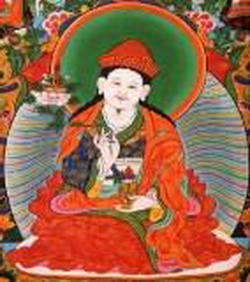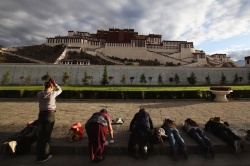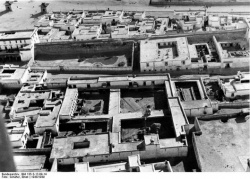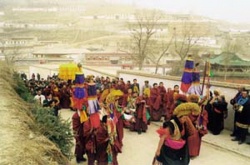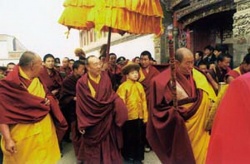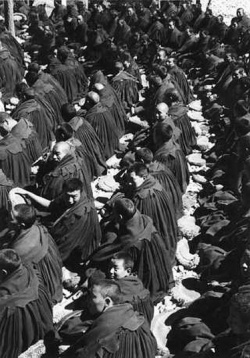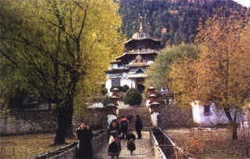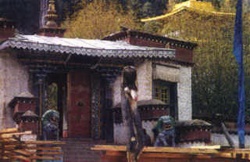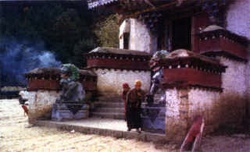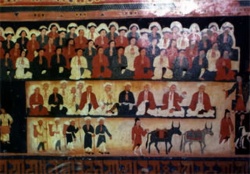(Nying-mapa)Tradition
The Nyingma (ancient) school of Tibetan or Vajrayana Buddhism was founded in the eighth century by the great enlightened Indian tantric master Padmasambhava, "the second Buddha," and is the oldest of the four schools of Tibetan Buddhism (Nyingma, Kagyu, Sakya, and Gelugpa).
Its teachings, transmissions and lineage of enlightened masters have continued unbroken to this day. At the heart of the Nyingma tradition is the practice of Dzog Chen, the most ancient and direct stream of wisdom within the teachings of Buddhism.
Mipham Rinpoche (1846-1912), one of Tibet's greatest scholars and masters, wrote: Crowning the banner of the complete teaching of the Buddha, is the beautiful ornament of the clear light teachings of Dzogpa Chenpo. Through practicing and realizing these teachings, tens of thousands of beings have become enlightened.
Although the Nyingmapa school is the oldest tradition of Tibetan Buddhism, its Dzog Chen teachings are the clearest, most effective and relevant to the needs of beings today. Untouched by the sometimes tragic events in Tibetan history, the Dzog Chen teachings have been passed down in an unbroken line from the Primordial Buddha Samantabhadra, teacher to student, to this day, in all their freshness, immediacy, and power.
"Dzog Chen is a state, the primordial state, the state of total awakening that is the heart essence of all the Buddhas and all spiritual paths, the summit of an individual beings spiritual evolution."
Dzog Chen can only be understood and fully realized with the direct guidance of a qualified and experienced Dzog Chen master. His Holiness Penor Rinpoche is such a being, an emanation of the great Dzog Chen master Vimalamitra. The Palyul Lineage Mingyur Dorje In Tibet, there were six mother monasteries which upheld the Nyingma tradition. In eastern Tibet, the foremost of these was the glorious Palyul. The land the monastery is situated on was blessed by many great
saints and bodhisattvas and it was during the time of the great vidyadhara Kuzang Sherab that the Palyul tradition was established and the monastery known as Palyul Namgyal Changchub Choling became one of the major Nyingma monastic institutions.
As with all Nyingma Dharma lineages, the Palyul holds the complete canon of the Mahayana sutras and tantras as well as the Kama (long), Terma (short) and Pure Vision transmissions.
However, the Palyul lineage is distinct in that it continues to practice, realize and transmit all the various lineages and transmissions that were held and passed on by Kunzang Sherab into one vast Dharma Ocean. The Kama or long lineage is the
combined oral tradition of Panchen Vimalamitra, the translator Vairocana and master Padmasambhava on the inner yogas of Generation Stage Maha Yoga, Transmission stage Anu Yoga and the Great Perfection stage Ati Yoga.
The Palyul also holds the Non-dual Great Seal Mahamudra - Great Perfection Ati Yoga, uniting the highest Nyingma teachings of Dzog Chen with the ornament of the Kagyu school, the Mahamudra of Marpa the translator, forefather of the Kagyu. From Kunzang Sherab to the present throne holder, His Holiness Penor Rinpoche, as well as the greater Palyul sangha, this has been maintained as a principal practice which includes:
clear light togyal,
[[inner togyal,
darkness practice,
dream practice,
training in the nature of sound and
pure realms practice.
The terma or short lineage refers to spiritual treasures (terma) that were concealed by Padmasambava and his close disciples to be revealed at a later, more appropriate time. These termas were hidden in both physical elements and within
beings mind streams, to be remembered and revealed in later incarnations. As such, the lineage for these termas is considered "short" historically, as opposed to the long lineages originating with Sakyamuni Buddha.
The principal terma lineages of the Palyul are those of Terton Nyang, Guru Chowang, Ratna Lingpa, Jigme Lingpa, Karma Lingpa and Mingyur Dorje. The Profound lineage of Pure Vision originates with Terton Mingyur Dorje's Nam Cho Great Perfection revelations, transmitted directly to Kunzang Sherab.
HOW THE TEACHINGS WERE TRANSMITTED
The teachings of the Nyingma (Old Translation) School are transmitted through two main systems, the kahma and terma lineages. Kahma refers to all the teachings and transmissions passed down through the centuries by the long lineage of teachers and
disciples. Terma refers to the previously hidden, rediscovered teachings of the short and direct lineage (nyegyu) from Guru Rinpoche and other enlightened ones. These masters transmit teachings directly through their deathless wisdom-body in visionary experience to the terton who discovers and reveals these teachings.
Such a short, fresh, direct, extremely powerful, and profound transmission is the terma of Jigme Lingpa's Longchen Nyingthig. Of the nine volumes of Jigme Lingpa's writings, two are gong-ter (wisdom-mind treasures).
Jigme Lingpa said that there are four purposes for the discovery of terma:
so the Dharma won't disappear;
so that the essential instructions don't become adulterated over long periods of time when mistakes and breaches of commitments and misunderstanding might take place;
so that the blessings do not fade;
and so that the direct lineage of transmission is maintained.
The terma provide teachings by Guru Rinpoche Padma Sambhava that are appropriate to the various needs and natures of different people in different places and times. One can obtain the ultimate fruit of the path by practicing
one particular terma alone, for each is complete in itself; yet in order to preserve and uphold all the teachings of the Buddhadharma in its totality, one must also to receive the kahma lineage transmission. Therefore, the kahma and terma are generally practiced and passed on inseparably.
Dzogchen teachings are generally classified into three main categories:
Sem De (Mind Class),
Long De (Expanse Class),
and Mengak-ki De (Pith-Instructions Class).
This threefold classification was made by Jampel Shenyen, Garab Dorje's disciple.
Twenty-one major tantras form the basis of Sem De.
Nine tantras (divided into groups of three: white, black, and multicolored) form the basis of Long De.
The Mengak-ki De category is subdivided into four subsections.
The fourth of these, Gyu Rangshung, is the text of root tantras and explanatory tantras in the most complete essentialized form. These are the pith-instructions proper.
The subsection of Gyu Rangshung in Mengak-ki De is itself divided into four groups known as Thigle Korshi. These four are
Chikor (Outer Cycle),
Nangkor (Inner Cycle),
Sangkor (Secret Cycle), and
Yangsang Lame (Supersecret and Highest).
This fourfold classification was made by Sri Simha, Jampel Shenyen's disciple.
Nyingthig is short for Nying-ki Thigle, meaning Heart-Essence or Innermost Essence. It refers to the most quintessential pith-instructions (mengak) of Ati Dzogpa Chenpo.
The term Nyingthig pertains solely to the Mengak-ki De (pith instructions) group of Dzogchen teachings. Moreover, it often refers in particular to the innermost or most profound and secret core of those pith-instructions, known as Yangsang Lame.
Therefore, these teachings are also known as Sangwa Nyingthig (Secret Heart-Essence), Osel Nyingthig (Luminous Innermost Essence), or Mengak Nyingthig (Heart-Essence of the Pith-Instructions).
Each of these terms refer to the unique Nyingthig teachings found primarily in the Yangsang Lame section of the Mengak-ki De. The seventeen main tantras ofMengak-ki De form the basis for the Yangsang Lame. (According to the tradition of
Vimalamitra, there are eighteen tantras; according to Guru Rinpoche's tradition, there are nineteen. These are mostly the same tantras, with very slight variations; both masters received this transmission from Sri Simha.) These tantras are found in the thirty-six-volume collection of Nyingma tantras called Nyingma Gyubum that were compiled by Terchen Ratna Lingpa, the greatest of the thirteen supreme Lingpas (tertons or treasure-masters).
It is difficult for ordinary beings to understand the tantras without the explanations of a qualified teacher. Gyalwa Longchenpa's Seven Treasures (Dzodun) was written in order to elucidate the extraordinarily profound meaning of the seventeen main tantras of Dzogpa Chenpo, as well as the teachings of all nine yanas (vehicles).
For the purpose of the actual practice of Dzogchen according to these tantras, Longchenpa gathered his own termas as well as those of Chetsun Senge Wangchuk (who was later reborn as Jamyang Khyentse Wangpo) and Pema Ladrey Tsel (Longchenpa's previous incarnation) in the form of the thirteen volume collection known as the Nyingthig Yabshi. This
Yabshi is the practice aspect of Longchenpa's writings and the basis of the Old Nyingthig. In it he synthesized the Bima Nyingthig of Vimalamitra and the Khandro Nyingthig of Guru Rinpoche and explained all the practical details in the light of his own realization.
The condensed essence of all the tantric teachings elucidated in the Seven Treasures of Longchenpa is contained in Jigme Lingpa's poetic Yonten Dzo, The Treasury of Enlightened Qualities. The practices included in the Nyingthig Yabshi are
condensed in a form that is easy to apply in Jigme Lingpa's four-volume Nyingthig Tsapod, which includes the renowned Triyig Yeshe Lama. This core teaching of the Tsapod is the basis of the extraordinary Dzogchen togal practice of the Longchen Nyingthig. These rare and extraordinarily profound teachings precisely explain various essential methods for directly actualizing the
innermost teachings of Ati Dzogpa Chenpo, the Great Perfection, the Peak Vehicle, which is the direct method for swiftly realizing the ultimate nature of the mind and attaining Buddhahood in the Rainbow Light Body. In modern times the Longchen Nyingthig is the main practice at the center of all these Dzogchen teachings and pith-instructions.
His Holiness Pema Norbu Rinpoche
His Holiness Penor Rinpoche His Holiness the Third Drupwang Pema Norbu (Penor) Rinpoche is the Supreme Head of the Nyingmapa Tradition of Tibetan Buddhism, and one of the foremost masters in the Buddhist Tradition of Tibet. He is the embodiment of the profound wisdom and limitless compassion which are the hallmarks of this tradition.
Throughout the Buddhist community he is respected for his vast knowledge and accomplishment, and for the integrity and strength with which he upholds the Buddha's teachings. Born in eastern Tibet in 1932, Penor Rinpoche was recognized as a young child as the incarnation of Vimalamitra and was installed in the Palyul monastery as its eleventh throne holder.
From a very early age he displayed many miraculous signs and abilities. His Holiness fled Tibet in 1956 and established Palyul Namdroling Monastery in southern India to preserve the Nyingma tradition. From its small beginning with a handful of monks, the monastery has grown to become the largest Nyingma monastery in the world, with over 1,500 monks and nuns and many incarnate Lamas.
The monastery also contains a large scholastic college and three year retreat centre. His Holiness is a pure holder of many ancient and important teachings and works tirelessly to preserve and spread these unbroken lineages of Dharma treasures, giving empowerments, teachings and transmissions all over the world. His Holiness is also responsible for the recognition and training of reincarnate lamas (tulkus).
"His Holiness Penor Rinpoche is one of the great Buddhist saints alive today. He is a great realized being, and seeing him is like being face to face with the Buddha and Padmasambhava." -Vajracharya Ven. Lama Jampa Rabjam, Rinpoche
Year 1. Ngondrö
As the foundation of the teachings of the Buddha Dharma, the retreat course begins with the preliminary practices, which focus on the purification of the Outer Doors (Body and Speech). Ngondrö consists of contemplation, insight, purification, offering and devotion practices. His Holiness will offer Refuge and Bodhisattva Vows, Vajrasattva
and Guru Rinpoche empowerments ("wangs"), fully qualifying retreatants to undertake Ngondrö practice. Either His Holiness or Khenpo Tsewang Gyatso will offer the transmission or "lung" of the actual practice TEXT. You will have the opportunity to receive clear explanations into the details of actually engaging in the practice ("tri"). You will also have the chance to engage in the actual practices with His Holiness, with Khenpo Tsewang Gyatso and with the sangha of monks on many occasions.
Year 2. Tsa Lung
After completing Ngondrö, the next step is to work with the breath and the positive and negative channels. The Tsa Lung practice is considered secret and should not be spoken about. As a result, those wishing admittance to this retreat must:
1) have completed their Ngondrö accumulations;
2) have special permission resulting from an interview with His Holiness or Khenpo Tsewang Gyatso; and
3) be able to participate in the whole month-long retreat.
The traditional signs of accomplishment, the generation of inner heat, will be measured at this retreat. Retreatants should be prepared to participate in a lot of physical activity. They should also be prepared in the event that His Holiness
requests them to repeat Ngondrö teachings and accumulations. This should not be viewed as a failure but as a great blessing. It is also not unusual to be asked to repeat. In the average class of monks in Namdroling Monastery, more than two-thirds are requested to repeat Ngondrö accumulations. One-month commitment required.
Year 3 - Dzogchen Tögyal
The complete explanation of these practices is only given from a master to a student when the student has made a wholehearted commitment to the teachings and has manifested a level of realization at which point these teachings are appropriate. With the practice of Trekchö, one cuts through delusion with diamond-like thoroughness. When this has been thoroughly accomplished, the
master will introduce Tögyal, a Dzogchen practice through which, via the posture and the gaze, one works directly with the light inherent in all phenomena using specific practices to reveal it within him or herself. Both of these practices are
indispensable for a deep understanding of what occurs in the between states that arise after death. These practices can only be achieved through receiving the inspiration and blessing from a living master who has realized them.
Year 4 - Shying Kham Nga Chyang
The five sense purification which encompasses instructions on purifying through:
a) sparkling of lights in which all impure phenomenon dissolves into pure appearance;
b) meditating within the state of darkness until the Buddha fields appear;
c) using the meditation practice that purifies sound until the sounds of the Pure Land are heard.
Subsequent Years.
After completing the Purification of the Five Senses, the actual practical transmission union of Mahamudra and Dzogchen begins. At this point, the instructions the individual needs are received from the Spiritual Teacher through examination and personal instruction. Through this thorough process, you have the chance to become naturally self-realizing. At
death, practitioners who have realized these practices manifest as clear light filling the pristine sky while their bodies transform into a rainbow, a phenomenon known as "Jalu," or achieving the rainbow body. Thus the significance of practicing
the non-dual Mahamudra & Dzogchen has helped hundreds of thousands of beings attain the state of enlightenment. To these days the transmission and the lineage still exist unbroken in Palyul tradition and thus this is a tremendous opportunity to learn these practices.
Dr. Akong Tulku Rinpoche
Dr. Akong Tulku Rinpoche was born in 1939 near Riwoche in Kham, Eastern Tibet. At a very young age, he was discovered and identified as the reincarnation of the first Akong, Abbot of Dolma Lhakang monastery in the Chamdo area of Kham. His religious training began here, and he also undertook training in traditional Tibetan medicine. He later went
to the monastic university of Sechen, where he received transmission of the quintessential mahamudra Kagyu Buddhist lineage from Sechen Kongtrul Rinpoche. His spiritual training as a holder of the Kagyu lineage was further completed under the guidance of HH the 16th Gyalwa Karmapa, who also certified him as a teacher of Tibetan medicine. Rinpoche also holds many lineages of the Nyingmapa tradition.
There are often multiple versions of tibetan names and even Tibetan Buddhist Scholars do not always agree on the spelling. These names of the Nyimgma lineage were translated from Tibetan to Chinese, and from Chinese into English. The English versions used here are those that most closely correspond to accepted spellings.
PADMASAMBHAVA, 7th Century AD
Yeshe Tsogyal, 8th or 9th Centuty AD
Longchenpa. 1308-1363
Jikme Lingpa, 1730 - 1798
Jigmed Gyalbai Myugu, 1750 - 1825
Orgyen Jigmei Chokyi Bangpo, 1808 - 1887
Lungtog Tanpai Nyima, early /mid - 19th Century
Akar Wangpo, mid -19th / early 20th Century
Khenpo Munsel, 1916 - 1994
Gyatrul Rinpoche
Born in Tibet in 1925, recognized as a Tulku of the great contemplative Sampa Kunkyap - educated in the Payul Domang Manastery in Eastern Tibet. Trained by such renowned adepts
Sangye Gon
Tulku Natsok Rangdrol
Palyul Chogtrul Rinpoche
Apkong Khenpo
Gyatrul Rinpoche - Books
Naked Awareness by Karma-Chags-Med, Gyatrul Rinpoche (Commentary), B. Alan Wallace (Translator), li Steele, Karma Chagme
Natural Liberation : Padmasambhava's Teachings on the Six Bardos by Padmasambhava, et al (Paperback - December 1997) (.com
A Spacious Path to Freedom : Practical Instructions on the Union of Mahamudra and Atiyoga by Karma-Chags-Med, et al (Paperback - December 1997)
Generating the Deity by Venerable Gyatrul Rinpoche, et al (Paperback - June 1996)
Tarthang Tulku (Nyingma)
[[Gesture of Balance by Tarthang Tulku(.co.uk
1. Skillful Means: Patterns for Success ~Tarthang Tulku Dharma Publishing Paperback - 1991 Usually dispatched within 24 hours (.co.uk
Enlightenment Is a Choice ~Tarthang Tulku Dharma Publishing Paperback - April 1998 Usually dispatched within 24 hours (.co.uk
The Crystal Mirror ~Tarthang Tulku (Editor) Dharma Publishing Paperback - 1 July, 1984 Usually dispatched in 2-3 days (.co.uk
Dynamics of Time and Space ~Tarthang Tulku Dharma Publishing Paperback - 1994 Special Order Our Price: £10.95
Time, Space, and Knowledge ~Tarthang Tulku Dharma Publishing Paperback - 1977
10. Mastery of Mind ~Tulku Tarthang Dharma Publishing Paperback - 1994 Special Order
Love of Knowledge ~Tulku Tarthang Dharma Publishing Paperback - 1987 Special Order
Mastering Successful Work ~Tarthang Tulku Dharma Publishing Paperback - 1994 Special Order Our Price: £10.95
Openness Mind ~Tarthang Tulku Dharma Publishing Paperback - 1978 Special Order Our Price: £9.95
Openness Mind ~Tarthang Tulku Dharma Publishing Paperback - 1978 Special Order Our Price: £9.95
Knowledge of Freedom ~Tulku Tarthang Dharma Publishing Paperback - 1984
Tulku Thondup
Enlightened Living, Tulku Thondup
Boundless Healing : Meditation Exercises to Enlighten the Mind and Heal the Body (Buddhayana Foundation Series) ~ Thondup, et al -- (Hardcover - October 2000)
Hidden Teachings of Tibet : An Explanation of the Terma Tradition of the Nyingma School of Buddhism by Tulku Thondrup Rinpoche, Harold Talbott
Masters of the Nyingma Lineage ~Leslie Bradburn
Ways of Work ~Nyingma
Nyinmapa & Dzogchen - Books & Authors:
Tarthang Tulku
Akong Tulku
Lama Mipham
Dudjom Rinpoche
Sogyal Ringpche
Thondup Tulku
Taming the Tiger : Tibetan Teachings on Right Conduct, Mindfulness and Universal Compassion Akong Tulku, Akong Tulku Rinpoche (.co.uk / com)
Enlightened Management ~Akong Tulku Rinpoche, Dona Witten Rider Paperback - 1 October, 1998
The Golden Letters : The Three Statements of Garab Dorje, the First Teacher of Dzogchen, Together With a Commentary ~Garab Dorje, John Myrdhin Reynolds (Translator) Snow Lion Publications Paperback - May 1996 Usually dispatched within 24 hours (.co.uk
The Nyingma School of Tibetan Buddhism : Its Fundamentals and History (Wisdom Advanced Book Blue) by Dudjom Rinpoche, et al Average Customer Review: Out of Print--Limited Availability
Natural Great Perfection: Spontaneous Songs and Dzogchen Teachings by Nyoshul Khenpo Rinpoche and Surya Das (copyright 1995, Snow Lion Publications). (.com
For further reading please see: Zangpo, Ven. Tsering and Khandro, Sangye, A Garland of Immortal Wish Fulfilling Trees: The Palyul Tradition of Nyingmapa, Ithaca, N.Y., Snow Lion Publications, 1988.
Ancient Wisdom : Nyingma Teachings on Dream Yoga, Meditation and Transformation by Jigma Tenpe Nuima Skyid Sdug Lam 'Khyer Bshugs So (Editor), et al (US
108 Recipes , Nyingma Institute
The Jewel Ladder ~Nyingma Lamrim, Tsepak Rigzin (Editor)
DZOGCHEN BOOKS
The Golden Letters : The Three Statements of Garab Dorje, the First Teacher of Dzogchen, Together With a Commentary Garab Dorje, John Myrdhin Reynolds (Translator) (co.uk / com
The Practice of Dzogchen ~Longchen Rabjam, et al Snow Lion Publications Paperback - 12 February, 1996 Usually dispatched within 24 hours (.co.uk
The Cycle of Day and Night : Where One Proceeds Along the Path of the Primordial Yoga : An Essential Tibetan Text on the Practice of Dzogchen by Namkhai Norbu, John Myrdhin Reynolds
Self-Liberation by Karma-Glin-Pa, Namkhai Norbu, Rigdzin Karma Lingpa, Reynolds, John Myrdhin Reynolds (Translator) (.com
You Are the Eyes of the World by Klon-Chen-Pa Dri-Med-Od-Zer, et al
Buddhahood Without Meditation: A Visionary Account Known As Refining Apparent Phenomena (Nang-jang) by Dudjom Lingpa, Richard Barron (Translator)
The Supreme Source : The Fundamental Tantra of Dzogchen Semde by Namkhai Norbu, et al (Paperback - September 1999)
Mipham's Beacon of Certainty: Illuminating the View of Dzogchen, the Great Perfection by John W. Pettit, et al (Paperback - November 1999)
Masters of Meditation and Miracles: The Longchen Nyingthig Lineage of Tibetan Buddhism by Tulku Thondup (.com .co.uk
Advice from the Lotus-Born by Padmasambhava
Tibetan Yogas of Dream and Sleep by Tenzin Wangyal, et al Self-Liberation by Karma-Glin-Pa, et al
Realizing Emptiness : The Madhyamaka Cultivation of Insight by Gen Lamrimpa, et al (Paperback - May 1999)
The Fundamental Wisdom of the Middle Way : Nagarjuna's Mulamadhyamakakarika by Nagarjuna, Jay L. Garfield (Translator) (Paperback - November 1995)
Nagarjuna's Seventy Stanzas: A Buddhist Psychology of Emptiness by David R. Komito, Geshe S. Rinchen (Translator) (Paperback - March 1999)
A Comprehensive Manual of Abhidhamma by Anuruddha, Bodhi
Lucid Exposition of the Middle Way : The Essential Chapters from the Prasannapada of CandrakIrti by CandrakIrti. (Hardcover - December 1979)
www.interlog.com
Tantric Practice in Nyingma - books
Rab-Gsal-Zla-Ba, Matthieu Ricard (Translator), Dilgo Khyentse Rinpoche (Paperback - October 1999) (.co.uk
Treasury of Precious Qualities ~Longchen Yeshe Dorje, The Padmakara Translation Group (Translator) Shambhala Publications Hardcover - 31 July, 2001 Usually dispatched in 2-3 days (.co.uk
Dzogchen View of Tantric Ngondro Enjoy the Dzogchen teachings of Jigdral Yeshe Dorje Dudjom Rinpoche, the first Supreme Head of the Nyingma School in exile from Tibet.
Dzogchen View of Tantric Ngöndro A Teaching by His Holiness Dudjom Rinpoche
http://www.aroter.org/articles/dudjom.htm
www.aroter.org
Vajrayana Buddhism practicing Nyingma Tantra and Dzogchen Flaming Jewel Dharma center and Rigdzin Community preserving the heart of Nyingma Tibetan Buddhist Tantra and Dzogchen in the East and West. www.flamingjewel.org
http://www.palyulcanada.org/nyingma.html
"Dzog Chen is a state, the primordial state, the state of total awakening that is the heart essence of all the Buddhas and all spiritual paths, the summit of an individual beings spiritual evolution." Dzog Chen can only be understood and fully realized with the direct guidance of a qualified and experienced Dzog Chen master. His Holiness Penor Rinpoche is such a being, an emanation of the great Dzog Chen master Vimalamitra.
keywords:
Dzog Chen, Atiyoga, Terma, Nyingmapa, Trekchod, Thodgal, Raibow light body, Rigpa, Garab Dorje, Patrul Rinpoche,
